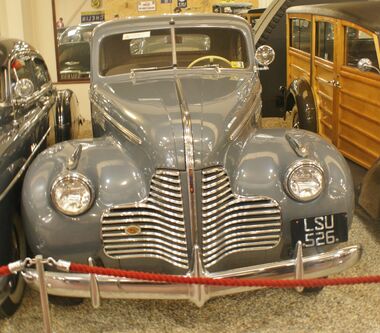
Buick Series 40 Special
The Buick Special is an automobile produced by the Buick Motor Division of General Motors, Flint, Michigan (USA).
1936–1958[]
From 1936 to 1958, Buick's Special model range represented the marque's entry level full-size automobile. By 1955, the Buick Special was one of America's best selling automotive series. Buick Specials had three VentiPorts (which were exhibited on this vintage Buick from 1949 through 1957) while more senior Buicks, with the exception of the Buick Super (which switched from three to four in 1955), had four.
Introduced in the middle of the 1955 model year the 4-door Buick Special Riviera, along with the 4-door Century Riviera and the 4-door Oldsmobile 98 Holiday and 4-door 88 Holiday, were the first 4-door hardtops ever produced.
The 1957 wheelbase was 122 inches. In the June, 1957 issue of Popular Mechanics, the Special was rated with a 0-60 mph time of 11.6 seconds, fuel economy of 17.4 mpg-US (13.5 L/100 km; 20.9 mpg-imp) at 50 mph (80 km/h), and ground clearance of 6.9 in (175 mm).
GM renamed the Buick Special the LeSabre for the 1959 model year, taking the name from the 1951 Le Sabre concept car.
1961-1963[]
In 1961, the car returned after a short absence of two years, but this time it was on the brand new unibody compact GM Y platform. The Special was powered by a 150 hp (112 kW) innovative aluminum-block 215 in³ V8, and had Dynaflow transmission and power steering. In mid-year a Skylark option was released with special trim, optional bucket seats and a 4 barrel version of the 215 that made 200 hp (149 kW).
In 1962, the Special was the first American car to use a V6 engine in volume production; it earned Motor Trend's Car of the Year for 1962. This 198 in³ Fireball was engineered down from the 215 and used many of the same design parameters, but was cast in iron. Output was 135 hp (gross) at 4600 rpm and 205 lb·ft (278 N·m) at 2400 rpm. In their test that year, Road & Track was impressed with Buick's "practical" new V6, saying it "sounds and performs exactly like the aluminum V8 in most respects." In 1963, the Special's body was restyled. Mechanically, however, the car was identical to the 1962 model. There was also some minor interior restyling, particularly to the dash and instrument cluster. The 1963 Special was available as a 2-door pillared hardtop coupe, a four dour sedan, a convertible, and a station wagon. Engine choices were a standard 198 cu in (3.2 l) V6 with 2-barrel carburetor and optional 215 cu in (3.5 l) V8 with 155 hp (116 kW) (two-barrel) or more powerful four-barrel (190 hp (140 kW) in 1962, 200 hp (150 kW) in 1963). Transmission choices were a 'three on the tree' manual transmission, a floor shift Borg-Warner T-10 4-spd. manual, or a two-speed Turbine Drive automatic. The two speed "Dual Path Turbine Drive" automatic was a Buick design and shared no common parts with the better known Chevrolet Power-Glide transmission.
The 1962 model sold 153,763, including 42,973 Skylarks.
The 1963 body was only produced for one year; it sold 148,750 copies, including 42,321 Skylarks. The entire car was redesigned for 1964. After that, the 215 found its way into the Rover P6 3500S in 1968, but was never sold in North America in any great numbers. It was also employed in other British cars, including the Morgan Plus 8, MG MGB GTV8, Land Rover, and Triumph TR8, as well as retrofits into MGAs and MGBs.
The Skylark became a separate series for 1962.
1964–1969[]
The Special, along with the upscale Skylark, were redesigned for the 1964 model year with separate body-on-frame construction—renamed the A-body -- and marketed as an intermediate-sized car. The Skylark was expanded to a full top-line series that now included two- and four-door sedans, two-door hardtop coupe and convertible, along with a station wagon. The other series models included the base Special and the slightly fancier Special Deluxe.
Also new for 1964 were engines. The capacity of the V6 engine was increased from 198 to 225 cubic inches, while the aluminum V8 was replaced by a new cast iron-block 300 cubic inch V8 with aluminum cylinder heads. This engine, produced until 1967, was based on the aluminum V8, and many parts (such as the cylinder heads) were interchangeable.
The Special nameplate was used on lower-priced intermediate-sized Buicks through the 1969 model year.
In 1968 and 1969, the Buick Special was dropped and only Special Deluxes were manufactured.
In 1970, the end of the Special came about when the Special Deluxe was dropped too in favor of the slightly upscale Buick Skylark.
1975[]
The Special returned briefly to the GM A platform as an entry level subseries of the Buick Century as the Buick Century Special. Century Specials were usually powered by Buick's own 231 V6; a V8 (from either Buick, Olds, or Chevrolet) was rarely optioned. It used the "fastback" roofline but was fitted with a landau roof that covered most of the rear quarter windows. The opening that was left was the same shape as the windows on the higher series formal-roof cars.



